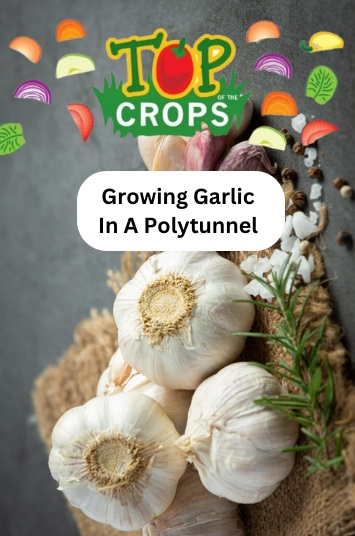Welcome to Top of the Crops! Today, you will learn about growing garlic in a polytunnel in the UK. Prepare for a prosperous garlic harvest by following our tips!
Garlic, some might say, is essential to provide life with a little flavour. Though it has a pungent smell, its taste adds a little something special to a range of dishes. Fortunately, this bulb in the onion family is easy to grow at home and it is a perfect choice for a polytunnel.
Garlic is the name given to several bulbs in the Allium genus that are used as a culinary ingredient. Usually when we talk about garlic we are talking about cultivars of Allium sativum.
| Jan | Feb | Mar | Apr | May | Jun | Jul | Aug | Sep | Oct | Nov | Dec | |
| Plant |  |
 |
 |
 |
 |
 |
||||||
| Harvest |  |
 |
 |
 |
Garlic will grow well in a range of different positions, as long as it receives full sun. it is important to choose a planting location that is not too shady or which becomes a frost pocket in winter.
Garlic grown in the ground needs a free-draining soil. If you have heavy clay soil where you live then it may be best to grow in raised beds or containers with plenty of organic matter. Though you can still plant garlic into heavy clay soil, certain diseases and other problems are more likely to arise.
Garlic can cope with soil with a range of different pH levels but will not tend to thrive in acidic soil. Therefore, if you have particularly acidic soil, you may wish to grow in containers or apply lime to the growing area in the autumn or winter.
What exactly you will need to grow garlic will depend on precisely where you have chosen to grow it. However, generally, you will require:
Garlic cloves for planting.
A suitable growing area or container in which to plant.
Perhaps cover for the newly planted crop if birds are an issue.
Organic mulch (such as autumn leaves) to spread around the crop.
Facility to water your crop in summer when necessary.
Garlic is a fairly easy crop to grow – a large part of the battle is simply to find a suitable location and when you do so, little care and attention will be required once you have planted your crop.
People usually plant garlic bulbs in autumn in the UK, though some varieties can be planted later – in late winter or even in very early spring.
Here is the process to follow to plant and grow garlic in your garden:
Garlic is usually harvested in early summer if planted in the autumn, and later in summer or in very early autumn if it was late winter/ spring sown.
The usual way to tell that the time to harvest is approaching is by the colour of the foliage. It will begin to turn yellowish and with some varieties, will flop over, when the time to harvest arrives.
What garlic looks like upon harvesting depends on which of the two main varieties – hardneck garlic and softneck garlic – you are growing. You'll find more information on these and other types of garlic later on in this guide.
Hardneck garlic varieties will not tend to flop over, but their foliage will start to turn yellow and brown. These bulbs tend not to store as well.
Softneck garlic varieties will usually bend over, so the foliage flops to the ground. The bulbs of these varieties are far better for storage.
Garlic is a great choice for container growing. It is a crop that takes up little space. Any pots that are at least 15-20cm deep can work well. Remember that the container must be free-draining.
Containers should be filled with a good quality, peat-free potting mix, either one that you purchase or one that you make yourself at home.
When planting garlic cloves in pots, you can get away with closer spacing than usual. As a rough rule, you can plant 3 cloves in a 15cm diameter container, 5 in a 20cm one, and up to 8 or so in a pot at least 25cm in diameter if growing garlic alone.
You can also consider growing garlic around the edges of a pot where another plant is grown. Companion planting can be a good idea even in container gardens.
Remember that some types and cultivars of garlic will store better than others. Fresh garlic can of course be lifted and used in a range of recipes right away. But it can also often be stored for longer periods of time for later use as long as it is stored correctly.
Hardneck garlic is best used up first, as it will not generally store for as long. Softneck garlic can be stored for a number of months in the right conditions.
To prepare garlic for storage, it should first be cured – this means leaving it in a warm, dry, well-ventilated place for the outer skin to dry out. Garlic bulbs that have been cured will store better.
Once cured, the garlic can be moved to a cool, dry location with temperatures of between 5 and 10 degrees C. for best results. The bulbs can be placed in a traditional ceramic container with holes for good airflow, in baskets, or mesh bags. They can also be plaited into traditional strings like onions, or wound only loops of string using their dried foliage.
If you already have supermarket garlic in storage in your home, you may wonder whether you can plant this instead of buying bulbs of a specific variety for planting. The answer is that supermarket garlic may grow just fine.
However, it is not the best idea to grow garlic from supermarket stock because this can introduce virus infections or other diseases to your garden.
Unfortunately, many of the garlic bulbs that we can purchase in supermarkets will also be unsuited to growth in our climate and conditions. And many will not be organic. Note that some will also be treated to prevent sprouting, so will not grow at all.
Where possible, therefore, it is best to buy bulbs of certified varieties, ideally organic, that don't carry diseases and which are best suited to growing where we live.
Caring for garlic growing in your garden is easy as long as you have placed the garlic in a suitable spot. In the right location, garlic should require little care.
One of the main jobs in looking after garlic is simply watering during dry periods in the spring and summer months. When watering, try to water at the base of the plants without wetting the foliage where possible. This can help to reduce the incidence of fungal problems. Always make sure excess water can drain away freely.
Another important job when growing garlic is weeding. This is a crop that can be very intolerant of competition. If you allow weeds to compete with or shade out garlic then the bulbs often won't grow very successfully and you will be left with a stunted yield.
Weed by hand, carefully, to avoid damage to the bulbs as these develop. And use organic mulch around the crop to suppress weed growth to a degree as well as providing other benefits.
When garlic produces flowering stems, this reduces the energy available to go into the bulb formation and can reduce the size of your crop.
When choosing garlic, it is important to consider carefully which variety or varieties you would like to grow. Most garlic varieties fall into one of two main categories – softneck and hardneck.
Softneck varieties have smaller cloves, more tightly packed together. They store for longer and are less likely to bolt (produce flowers) as long as the conditions are right. However, northern gardeners may find them a little less tolerant of cold temperatures than hardneck types.
Examples include 'Arno' 'Cristo', 'Germidour' and 'Solent Wight' which all have an award of garden merit from the RHS.
Hardneck varieties have larger, looser bulbs and a stronger taste. They are prone to bolting, but the scapes or flowering shoots produced can be a valuable subsidiary yield. They will not store as well, nor for as long, as softneck types.
Examples include 'Lautrec Wight' which is a classic hardneck variety from France, also with an award of garden merit.
Rocambole is the name given to varietals of garlic - Allium sativum var. ophioscorodon as well as to the sand leek, Allium scorodoprasum. Both of these are used in similar ways to other garlic varieties. Rocambole garlics are worth considering, with their looping scapes and excellent flavour. These garlics are hardneck types.
While the garlic varieties mentioned above are typically grown as annual crops in a vegetable garden, it is worth remembering that there are also some perennial types that you might grow that can remain in your garden over a number of years.
One of the best known perennial garlics is Allium ampeloprasum var. ampeloprasum, also known as elephant garlic. This produces much larger, and milder tasting cloves but other than spacing which should be a little greater, care requirements don't really differ at all and they like similar growing conditions.
Wild garlic, Allium ursinum, also known as ramps or ramsons, is another rather different perennial garlic to grow. Unlike other garlics, it likes a woodland environment and will thrive in damp shade, liking slightly acidic conditions. The leaves, flowers and bulbs of the plants can all be eaten.
If you are interested in perennial food production, there are also many other garlic-like alliums to consider growing in your garden.
Though garlic is quite easy to grow, problems can of course arise.
Cover garlic to prevent birds from plucking newly planted cloves from the ground.
Ensure good airflow and weed well to reduce the chances of this fungal infection, which causes small orange dots to appear on the leaves.
Companion plant garlic with strong smelling herbs or carrots and cover where necessary to reduce the chances of onion fly infestation. Onion fly maggots can eat through garlic bulbs and kill your crop.
Rotate crops to avoid this disease which can build up in the soil. Don't grow alliums in an area affected with this problem for at least 15 years.
These soil-borne nematodes can also affect your garlic crop. Do not grow hosts in this area of your garden for at least 3 years.
Adverse weather in spring can cause top-setting. Top set cloves can be used normally.
Plant stress of any kind can cause bolting. But remember that flowers and flower stems can be eaten.
Split bulbs are usually a sign that you did not harvest in a timely fashion. These can still be used but will not store.
Growing under cover can reduce problems with birds lifting the crop, and allow growth of more tender varieties in more northerly, colder and wetter regions.
Grow in raised beds or containers where soil is heavy.
Rotate garlic with other crops.
Use garlic as a companion plant – its strong scent can confuse, distract or repel a wide range of pest species and keep other crops safe.
I often plant garlic around the edge of beds in my polytunnel, though there are many ways to integrate this useful crop into your polytunnel garden.
Myers, J., (2023) 31 Recipes for Garlic Lovers. Taste of Home. [online] Available at: https://www.tasteofhome.com/collection/recipes-for-garlic-lovers/ [accessed 14/12/23]
